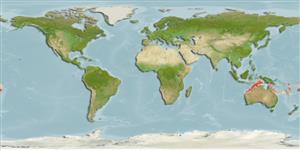Environment: milieu / climate zone / depth range / distribution range
экология
морской демерсальный; пределы глубины 73 - 210 m (Ref. 5222). Tropical; 1°N - 23°S, 115°E - 177°W (Ref. 5222)
Eastern Indian Ocean: Western Australia. Eastern Central Pacific: American Samoa and the Phoenix Islands.
Size / Вес / Возраст
Maturity: Lm ? range ? - ? cm
Max length : 71.0 cm TL самец/пол неопределен; (Ref. 125599); наибольший вес (опубликованные данные): 4.5 kg (Ref. 125599)
колючие лучи спинного плавника (общее число): 11; членистые (мягкие) лучи спинного плавника (общее число): 16-17; колючие лучи анального плавника 3; членистые (мягкие) лучи анального плавника: 8. Preopercle angle with 2 - 4 distinctly enlarged serrae; upper edge of the operculum straight or nearly so; nostrils small, subequal; maxilla extends to below rear half of the eye. Color is pale brownish gray with yellow or golden brown spots on the head, nape and chest. A row of dark yellowish brown spots along the margin of the soft dorsal and anal fins and the rear edge of the caudal fin. Pelvic fins with yellowish brown and whitish streaks and a few yellowish brown spots distally. Further characterized by body depth contained 2.7-3.4 times in SL; head length 2.4-2.7 times in SL; flat to convex interorbital area; 2-4 distinctly enlarged serrae at preoopercle angle; upper edge of operculum nearly straight or straight; small anterior and posterior nostril, subequal; maxilla extends to below rear half of eye; 2 rows of teeth on midlateral part of lower jaw (Ref. 89707).
Nothing has been published on the biology of this rare species. The apparent rarity of this species is probably a result of its deep-water habitat and the fact that it was only recently described as a new species.
Life cycle and mating behavior
половая зрелость | размножение | нерест | икра | Fecundity | личинки
Heemstra, P.C. and J.E. Randall, 1993. FAO Species Catalogue. Vol. 16. Groupers of the world (family Serranidae, subfamily Epinephelinae). An annotated and illustrated catalogue of the grouper, rockcod, hind, coral grouper and lyretail species known to date. Rome: FAO. FAO Fish. Synop. 125(16):382 p. (Ref. 5222)
Статус Красного Списка МСОП (Ref. 130435)
Угроза для людей
Harmless
Использование человеком
рыболовство: интереса не представляет
дополнительная информация
народные названиясинонимыобмен веществхищникиэкотоксикологияразмножениеполовая зрелостьнерестSpawning aggregationFecundityикраРазвитие икры
ссылкиаквакультура (рыбоводство)особенности рыбоводствастепень растяжениягенетикаElectrophoresesнаследуемостьболезниобработкаNutrientsMass conversion
соавторыизображенияStamps, Coins Misc.звукиCiguateraскоростьтип плаванияжаберная областьOtolithsмозгзрение
инструменты
Специальные отчеты
Скачать в формате XML
ресурсы в Интернет
Estimates based on models
Preferred temperature (Ref.
123201): 21.4 - 25.3, mean 23.3 °C (based on 34 cells).
Phylogenetic diversity index (Ref.
82804): PD
50 = 0.5000 [Uniqueness, from 0.5 = low to 2.0 = high].
Bayesian length-weight: a=0.00955 (0.00556 - 0.01641), b=3.00 (2.86 - 3.14), in cm total length, based on LWR estimates for this species & Genus-body shape (Ref.
93245).
Trophic level (Ref.
69278): 3.9 ±0.5 se; based on size and trophs of closest relatives
устойчивость к внешним воздействиям (Ref.
120179): низкий, минимальное время удвоения популяции 4.5-14 лет (Preliminary K or Fecundity.).
Fishing Vulnerability (Ref.
59153): Moderate to high vulnerability (48 of 100).
Nutrients (Ref.
124155): Calcium = 122 [54, 276] mg/100g; Iron = 1.04 [0.50, 2.42] mg/100g; Protein = 17.6 [15.9, 19.1] %; Omega3 = 0.253 [0.133, 0.476] g/100g; Selenium = 58.1 [28.2, 130.8] μg/100g; VitaminA = 68.7 [16.7, 285.5] μg/100g; Zinc = 1.46 [0.92, 2.38] mg/100g (wet weight);
